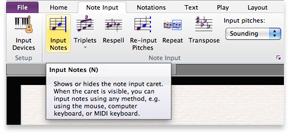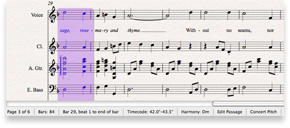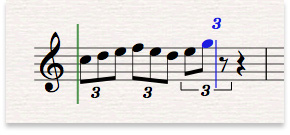Task-oriented user interface
 New ribbon-style interface
New ribbon-style interface
The ribbon is a wide band of command buttons at the top of every Sibelius window, replacing the old menus and toolbar. All of the program’s features are logically arranged into 10 tabs, plus the special File tab. From left to right, the arrangement of features describes the typical workflow of creating a score, from adding instruments and bars, through inputting notes, adding notational elements and other markings, text, layout, part preparation, review, and final output.
Every feature has its own icon, text description, and, when you hover over a button, an extended screen tip that provides contextual help. The ribbon intelligently resizes to match the size of the document window or your computer’s display, so you can always access every feature with no more than three clicks.
Tabbed document interface
Sibelius 7 employs a modern tabbed document interface, just like your web browser. Open individual parts in separate tabs within the same parent window, and quickly switch between them using the handy tab bar. Open any tab in a new window by right-clicking the tab bar and choosing New Window.
 Ergonomic improvements
Ergonomic improvements
The new user interface in Sibelius 7 is packed with improvements to make working with the software faster and more efficient.
Important and commonly used options are front and center on the ribbon. For example, you can now change page size, orientation, margins, and staff size directly on the ribbon, and see your score update in real time.
These small but useful improvements are everywhere. For example, the notational elements that you used in your score are placed at the top of rich, graphical menus so you can quickly create them again. You can also create time signatures by hitting the single-key shortcut T, then typing the top and bottom numbers, and hitting Return.
Keyboard access
Sibelius 7 is the most accessible version ever. Every feature on the ribbon can be accessed via a special sequence of key presses called key tips. What’s more, Sibelius now has built-in support for screen-reading software on Windows, making it more accessible than ever to blind and visually impaired musicians.
Don’t worry if you’re a power user who has memorized many keyboard shortcuts. With a few exceptions, earlier keyboard shortcuts work just the same in Sibelius 7—and all keyboard shortcuts are fully customizable.
 Status bar
Status bar
The new status bar at the bottom of every Sibelius document window provides quick access to document view options such as zoom and Panorama. It also shows you useful, context-sensitive information about your score, including the number of bars in your score, duration of the current selection in bars and timecode, the implied harmony of the selected notes, and much more.
 Make it stick
Make it stick
Sibelius 7 includes two useful new features for note input. You can now start and stop markings, such as slurs and hairpins, during note input. Input one note, hit S to start a slur, then input some more notes—Sibelius automatically snaps the right-hand end of the slur to each successive note. When you want the slur to stop, simply type Shift-S. This works for any kind of line, and is a tremendous time saver.
Along with sticky lines, Sibelius 7 introduces sticky tuplets. If you need to input a run of tuplets, input the first note of the first tuplet, then hit the single-key shortcut to make tuplets sticky, and input more notes. As you get to the end of each tuplet, Sibelius automatically creates a new one, until you hit the shortcut again to switch the stickiness off.


